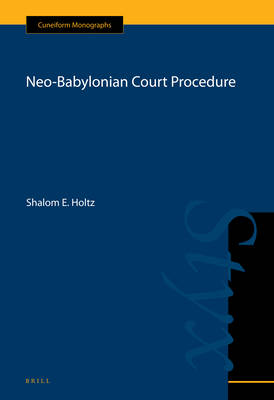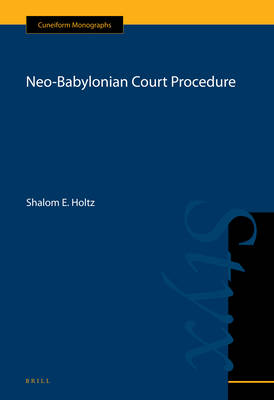
- Afhalen na 1 uur in een winkel met voorraad
- Gratis thuislevering in België vanaf € 30
- Ruim aanbod met 7 miljoen producten
- Afhalen na 1 uur in een winkel met voorraad
- Gratis thuislevering in België vanaf € 30
- Ruim aanbod met 7 miljoen producten
Zoeken
€ 288,45
+ 576 punten
Omschrijving
Even though scholars have known of Neo-Babylonian legal texts almost since Assyriology's very beginnings, no comprehensive study of court procedure has been undertaken. This lack is particularly glaring in light of studies of court procedure in earlier periods of Mesopotamian history. With these studies as a model, this book begins by presenting a comprehensive classification of the text-types that made up the "tablet trail" of records of the adjudication of legal disputes in the Neo-Babylonian period. In presenting this text-typology, it considers the texts' legal function within the adjudicatory process. Based on this, the book describes the adjudicatory process as it is attested in private records as well as in records from the Eanna at Uruk.
"This study of textual typologies and adjudication processes will be of immense value to Assyriologists, biblical scholars and historians of law alike. This is without mentioning the wealth of social and economic insights evident in each case, let alone the valuable identification of Neo-Babylonian formulaic legal expressions."
S. Jacobs
"Overall, Holtz's work is replete with important data, insightful in its analysis and judicious in its interpretive decisions. It should serve not only as an important resource but also as a significant statement on the function of law and judicial procedure at an important time in Mesopotamian history." Bruce Wells, Saint Joseph's University
"This study of textual typologies and adjudication processes will be of immense value to Assyriologists, biblical scholars and historians of law alike. This is without mentioning the wealth of social and economic insights evident in each case, let alone the valuable identification of Neo-Babylonian formulaic legal expressions."
S. Jacobs
"Overall, Holtz's work is replete with important data, insightful in its analysis and judicious in its interpretive decisions. It should serve not only as an important resource but also as a significant statement on the function of law and judicial procedure at an important time in Mesopotamian history." Bruce Wells, Saint Joseph's University
Specificaties
Betrokkenen
- Auteur(s):
- Uitgeverij:
Inhoud
- Aantal bladzijden:
- 335
- Taal:
- Engels
- Reeks:
- Reeksnummer:
- nr. 38
Eigenschappen
- Productcode (EAN):
- 9789004174962
- Verschijningsdatum:
- 24/04/2009
- Uitvoering:
- Hardcover
- Formaat:
- Genaaid
- Afmetingen:
- 165 mm x 244 mm
- Gewicht:
- 703 g

Alleen bij Standaard Boekhandel
+ 576 punten op je klantenkaart van Standaard Boekhandel
Beoordelingen
We publiceren alleen reviews die voldoen aan de voorwaarden voor reviews. Bekijk onze voorwaarden voor reviews.











